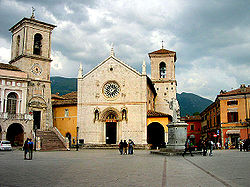
Monks of Norcia
Encyclopedia

The Benedictine Monks of Norcia (Italian: Monastero di San Benedetto di Norcia) are located in Norcia
Norcia
Norcia is a town and comune in the province of Perugia in southeastern Umbria, located in a wide plain abutting the Monti Sibillini, a subrange of the Apennines with some of its highest peaks, near the Sordo River, a small stream that eventually flows into the Nera...
(formerly Nursia), Italy, in the extreme southeast tip of Umbria
Umbria
Umbria is a region of modern central Italy. It is one of the smallest Italian regions and the only peninsular region that is landlocked.Its capital is Perugia.Assisi and Norcia are historical towns associated with St. Francis of Assisi, and St...
beneath the slopes of the Sibylline Mountains. The current monastery is physically located above the 5th century ruins of the the house of St. Benedict and his twin sister St. Scholastica, and has been the location of monastic communities since the tenth century AD. Today the Monks of Norcia care for the spiritual, pastoral, and temporal needs of approximately 50,000 pilgrims from around the world who annually visit the birthplace of Sts. Benedict and Scholastica.
History
In the 8th century an oratory was built so pilgrims could pray at the place of St. Benedict’s birth. Monks came to Norcia in the 10th century, and remained in one form or another until 1810, when they were forced to flee under the new laws of the Napoleonic CodeNapoleonic code
The Napoleonic Code — or Code Napoléon — is the French civil code, established under Napoléon I in 1804. The code forbade privileges based on birth, allowed freedom of religion, and specified that government jobs go to the most qualified...
. The current Benedictine community was founded in Rome on September 3, 1998, without being conditioned by previous historical circumstances. These original monks transferred from Rome to Norcia on December 2, 2000, in the great Jubilee Year, becoming The Benedictine Monks of Norcia. They were charged by Rome to care for the Basilica of San Benedetto (built over the birthplace of St Benedict and St Scholastica) and for the many visiting pilgrims. The Benedictines of Norcia see themselves as humble instruments for the necessary New Evangelization of Europe. As of July 2011 there are nineteen monks living at Norcia, four of which are ordained priests and two novices.
Charism
The charism of the Monks of Norcia is “to return to the spirit of the founder,” following the explicit appeal of the Vatican II document on Religious Life, Perfectae Caritatis. On April 21, 2009 the Holy See entrusted to the community the special liturgical apostolate of celebrating both forms of the Roman Rite (in utroque usu - “according to both usages”): the Extraordinary and the Ordinary form. This makes the Benedictine Monks of Norcia one of the few religious communities throughout the world (although the number is steadily growing) that celebrates both forms of the Roman Rite (See "Traditionalist Communities in good standing with the Holy See" under Traditionalist CatholicTraditionalist Catholic
Traditionalist Catholics are Roman Catholics who believe that there should be a restoration of many or all of the liturgical forms, public and private devotions and presentations of Catholic teachings which prevailed in the Catholic Church before the Second Vatican Council...
).
The Seal
The Seal of the Monastery is divided into two sections. On the left hand side is the symbol of the Celestine monks who were present in Norcia before being suppressed by the Napoleonic laws of 1810, representing the continuity with the past. The CelestinesCelestines
Celestines are a Roman Catholic monastic order, a branch of the Benedictines, founded in 1244. At the foundation of the new rule, they were called Hermits of St Damiano, or Moronites , and did not assume the appellation of Celestines until after the election of their founder to the Papacy as...
were part of a wide-spread movement in the Church in the thirteenth century which emphasized the power of the Holy Spirit. Their symbol, therefore, is a large S, standing for Spiritus Sanctus.
The right side of the seal represents the present: a stump with new shoots of life growing from it. The stump represents monastic life violently cut off in 1810. The new shoots of life represent the present community, and the three leaves represents the three original monks who arrived in Norcia in 2000. As the prophet Isaiah says: “There shall come forth a shoot from the stump of Jesse, and a branch shall grow out of his roots” (Is 11:1). This image has always been a sign of hope.
External References
- The Monks of Norcia Website http://osbnorcia.org/
- The Catholic Encyclopedia http://www.newadvent.org/cathen/02467b.htm
- Perfectae Caritatis http://www.vatican.va/archive/hist_councils/ii_vatican_council/documents/vat-ii_decree_19651028_perfectae-caritatis_en.html

